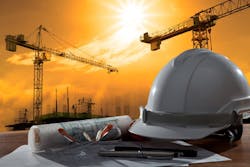Electrical Marketing's Leading Economic Indicators: Jan. 24, 2025 Update
Single-family building permits see some growth in December
Building permits in December were at a seasonally adjusted annual rate of 1,483,000, -0.7% below the revised November rate of 1,493,000 and -3.1% below the Dec. 2023 rate of 1,530,000. Single-family authorizations in December were at a rate of 992,000, +1.6% above the revised November figure of 976,000.
AIA construction forecast sees modest gains in 2025
After increasing by almost 20% in 2023 and another 6% last year, construction spending for nonresidential buildings — commercial, industrial and institutional facilities — is projected to slow dramatically in 2025 and 2026. Panelists in The American Institute of Architects’ latest Consensus Construction Forecast expect a modest outlook on construction spending activity.
The Consensus Construction Forecast expects gains of only +2.2% this year and +2.6% in 2026. Spending on institutional facilities is projected to see the strongest gains of +6% this year while commercial construction spending is expected to increase by only +1.7% in 2025. The Consensus Construction Forecast panelists, a group comprised of the leading construction forecasters from across the country made the following forecasts:
• Projected gains are not expected to increase construction volume and increases in construction.
spending will be so modest that they likely won’t even cover rising material and labor costs.
•Warehouse construction has driven retail and commercial growth and is expected to slow, because they have become overbuilt in many areas of the country.
•Health care and education are poised for health gains. The major institutional sectors less prone to boom-and-bust pattern.
“The modest outlook is partly based on a few expected headwinds to building activity, including potential tariffs on imports,” said AIA Chief Economist Kermit Baker, in the press release. “There is also policy concern around how the construction labor force might be impacted by emerging immigration policy. Construction sector spending has been exceedingly strong – albeit unusually unbalanced – and coupled with these headwinds the projections are only very modest gains the next two years.”
Single-family building permits see some growth in December
Building permits in December were at a seasonally adjusted annual rate of 1,483,000, -0.7% below the revised November rate of 1,493,000 and -3.1% below the Dec. 2023 rate of 1,530,000. Single-family authorizations in December were at a rate of 992,000, +1.6% above the revised November figure of 976,000.
AIA construction forecast sees modest gains in 2025
After increasing by almost 20% in 2023 and another 6% last year, construction spending for nonresidential buildings — commercial, industrial and institutional facilities — is projected to slow dramatically in 2025 and 2026. Panelists in The American Institute of Architects’ latest Consensus Construction Forecast expect a modest outlook on construction spending activity.
The Consensus Construction Forecast expects gains of only +2.2% this year and +2.6% in 2026. Spending on institutional facilities is projected to see the strongest gains of +6% this year while commercial construction spending is expected to increase by only +1.7% in 2025. The Consensus Construction Forecast panelists, a group comprised of the leading construction forecasters from across the country made the following forecasts:
• Projected gains are not expected to increase construction volume and increases in construction.
spending will be so modest that they likely won’t even cover rising material and labor costs.
•Warehouse construction has driven retail and commercial growth and is expected to slow, because they have become overbuilt in many areas of the country.
•Health care and education are poised for health gains. The major institutional sectors less prone to boom-and-bust pattern.
“The modest outlook is partly based on a few expected headwinds to building activity, including potential tariffs on imports,” said AIA Chief Economist Kermit Baker, in the press release. “There is also policy concern around how the construction labor force might be impacted by emerging immigration policy. Construction sector spending has been exceedingly strong – albeit unusually unbalanced – and coupled with these headwinds the projections are only very modest gains the next two years.”



